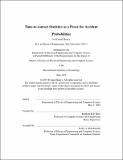Time-to-contact statistics as a proxy for accident probabilities
Author(s)
Haulcy, R'mani(R'mani Symon)
Download1124924338-MIT.pdf (2.540Mb)
Other Contributors
Massachusetts Institute of Technology. Department of Electrical Engineering and Computer Science.
Advisor
Berthold K.P. Horn.
Terms of use
Metadata
Show full item recordAbstract
Accidents are relatively rare, and this makes it difficult to study the impact of traffic system changes or vehicle control changes on accident rates. One potential solution to this problem is the use of time-to-contact (TTC) statistics as a proxy for accident probabilities. Low TTC can be used as a measure of potential danger. Simulations were performed to explore whether inverse TTC can serve as a good proxy of accident probability. The resulting data was then analyzed to investigate how inverse TTC varies with the mixture of vehicles with bilateral control as opposed to car-following control. Previously, it was found that a relatively high mixture ratio is needed to prevent phantom traffic jams. The results in this paper show that there is a benefit to mixing bilateral control cars into general traffic, even at relatively low mixture ratios. Simulations were also performed to see how acceleration and jerk vary with the mixture of vehicles with bilateral control so that passenger comfort could be quantified. The results show that bilateral control improves passenger comfort.
Description
This electronic version was submitted by the student author. The certified thesis is available in the Institute Archives and Special Collections. Thesis: S.M., Massachusetts Institute of Technology, Department of Electrical Engineering and Computer Science, 2019 Cataloged from student-submitted PDF version of thesis. Includes bibliographical references (pages 56-58).
Date issued
2019Department
Massachusetts Institute of Technology. Department of Electrical Engineering and Computer SciencePublisher
Massachusetts Institute of Technology
Keywords
Electrical Engineering and Computer Science.